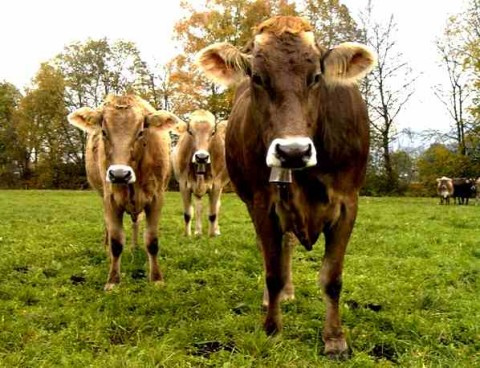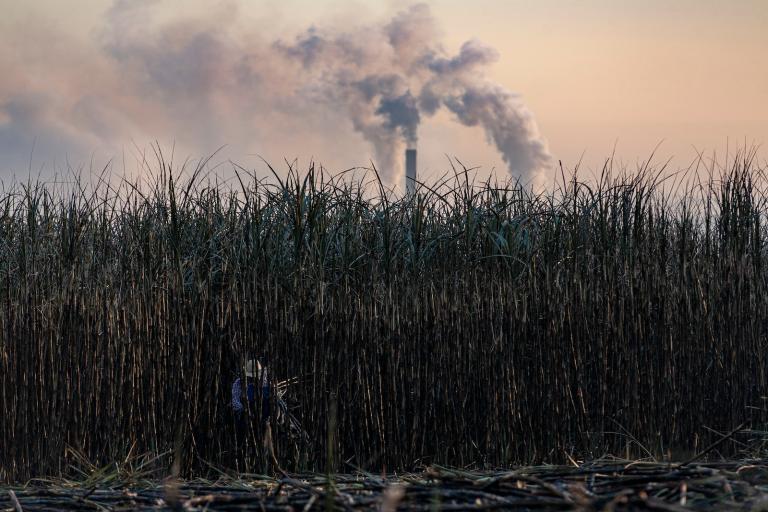
Photo by Noskule.
You’ve probably never heard of Frank Stronach. Sure, he’s a Canadian billionaire — yes, they have them there! — and an auto-parts cum horseracing magnate. But rather than hanging up his wrench spurs retiring, he’s decided to try his hand at turning grass-fed beef back into a mass-market product.
According to this report in Macleans (Canada’s equivalent of TIME magazine), Stronach is buying up land outside of Ocala, Fla., at a furious pace — 70,000 acres and counting. His plan: to create a massive ranch with “30,000 cattle, a 61,000-sq.-foot abattoir that would slaughter up to 300 cows a day, and a biomass power plant that would extract methane from manure.” It’s a grand vision:
Stronach’s Adena Springs ranch plans to market its beef to Florida grocery stores for consumers keen on fresh local produce, as well as serve the meat at Stronach’s network of racetracks. There are plans for a restaurant chain that would serve Adena Meats, and Stronach hopes to expand the business across the United States and Canada.
But it’s not just the numbers that caught my eye. So did the fact that he intends to put slaughter facilities on the ranch itself and to raise and finish the cattle on grass. According to Adena Springs’ General Manager Mark Roberts, Stronach — echoing many a sustainable livestock farming advocate — expects the cows “will have all good days and then one bad day.”
Despite those sentiments, at the scale he’s planning, he’s not exactly a latter-day Joel Salatin (who believes the proper scale for an individual operation is small). And he stands in contrast even to one of the few “large-scale” natural meat operations already out there — Niman Ranch, which achieved its significant capacity through a network of small farms.
Some might argue that his grand dream of returning big cattle ranches to grass and eliminating the long (and often horrific) trips from ranch to slaughter is too much turning-back-the-clock and not enough hard-nosed-business. After all, before the advent of huge corn-finishing feedlots and massive slaughterhouses several decades ago, all cattle were raised this way. The industry changed for a reason: cost to the producer. But if this article in Fast Company is any indication, Stronach knows where the meat market is heading. The article reads:
It appears that well-heeled red meat fans are willing to eat less as long as they can reward themselves by trading up in quality and taste … Grass-fed red meat is also finding a broader market. Grass-fed is promoted as a more humane way of raising beef because it’s centered in pastures, not in feedlots. It also offers more protein than corn-fed beef, although its environmental benefits are still up for debate.
It’s that trend that Stronach hopes to tap into. Premium prices for a premium product that’s already increasing its market share. And with a new long-term study showing that every daily serving of red meat (including the so-called “Other White Meat”!) increases your odds of early death by 12 percent, perhaps folks will decide to eat less, higher-quality meat and live longer.
And yet it’s not at all clear that Stronach has a mind for environmental stewardship. He has reportedly asked local Florida officials for permission to dig 130 water wells on his property and pump 13 million gallons of water a day from Ocala’s aquifer. As Macleans observes, “It’s more water than the entire city of Ocala uses in a day.” Why you’d need to do this in rainy Florida for a grass-fed operation is an open question — and a red flag.
Stronach isn’t new to farming — although to date he’s raised only thoroughbred horses. And there is this admittedly bizarre and failed attempt to house displaced Hurricane Katrina survivors in a planned community built around residents growing their own food.
Still, larger questions remain about what it would take to scale the grass-fed model back up in a sustainable way. I spoke with Nicolette Hahn Niman, author of Righteous Porkchop and wife of Niman Ranch founder Bill Niman, about Stronach’s plan. While it’s too early to know for sure, she thinks the ranch holds a huge amount of potential, if properly managed.
Her principal concern isn’t necessarily the water (unless it’s used for irrigation, which would negate many of the environmental benefits of grass-based agriculture). Instead, Niman noted that her husband emphasizes “raising livestock in the right locale.” They believe the far West is ideal livestock country since so much of the land isn’t suited to farming (Bill Niman left Niman Ranch in 2007 and now raises cows, pigs, and poultry in Northern California under the name BN Ranch). So, the question is: Is Florida a smart alternative?
Florida has a sizable cattle business, enough to crack the country’s Top 10 list for cattle production. But, as this local cattlemen’s association website observes, most of the cattle raised in Florida is sent to feedlots out of state (of course, even in the western states, cattle are moved long distances for finishing). The point is that Stronach certainly isn’t trying to perform the livestock equivalent of growing rice in the desert. It may simply be that the most affordable land is in Florida, a state hit hard by the Great Recession, making it the best place to build a ranching empire.
Even so, as Niman observed, “the devil is in the details,” and other than the acreage Stronach owns and the number of wells he wants to drill, much remains unknown. As she pointed out, we don’t know who is running the cattle operation — and if they are practitioners of holistic management or other sustainable techniques for grass-based systems. Unfortunately, Niman says, “odds are, probably not.”
I did reach out to Manager Mark Roberts myself to see if I could get any further details, but he has yet to respond to my requests. And that’s too bad, because Stronach has a real opportunity to blaze a trail in an area that hasn’t seen a huge impact from sustainable agriculture. Florida has a surprisingly small organic agricultural sector and, of course, it’s also home to the stark, yet slowly evolving, labor challenges among tomato workers.
Stronach is holding out the tantalizing possibility of changing that landscape in a big way. But for now we’ll have to watch and see what it is he really has in mind.




